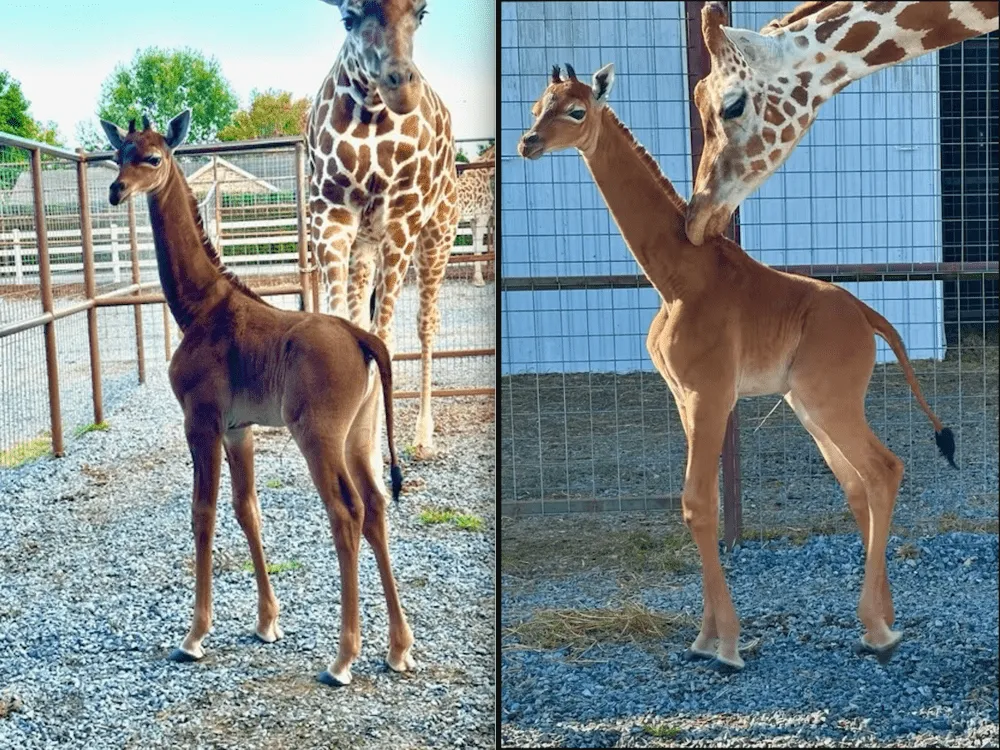A captivating spectacle unfolded at Brights Zoo, nestled in northeastern Tennessee, as an extraordinary event transpired last month – the birth of a female reticulated giraffe devoid of the characteristic spots that typically define her species. This remarkable anomaly has ignited excitement among animal enthusiasts and experts alike, shedding light on the astonishing variations nature can bestow upon us.
Renowned for their towering presence, giraffes stand as the tallest land mammals, their graceful forms reaching an impressive height of 14 to 15 feet. What sets these majestic creatures apart during childbirth is that the newborn calves are already a staggering 6 feet tall. Traditionally, these calves are adorned with distinctive brown spots, creating an iconic visual spectacle. However, defying conventional norms, Brights Zoo, situated in Limestone, Tennessee, unveiled a groundbreaking occurrence on July 31 – the birth of a reticulated giraffe without any spots.

This rare spotless birth has not only captured the imagination of zookeepers and visitors but has also spurred inquiries into the scientific significance of this phenomenon. The team at the zoo, in conjunction with giraffe experts, has deemed this reticulated giraffe a unique case, making her the only solid-colored individual of her kind on the entire planet.
The curiosity surrounding this birth has prompted David Bright, the director of the zoo, to engage with fellow professionals in the field across the country. The aim is to gauge the rarity of this extraordinary occurrence within the context of global giraffe populations. The exceptional nature of this event becomes evident when considering that the only documented instance of a reticulated giraffe born without spots dates back to 1970s Japan.
Pictures of this remarkable calf, standing alongside her mother in stark contrast without her characteristic spots, can be found on the Brights Zoo Facebook page. Adding an interactive touch, the zoo has opened the floor for public participation in naming the newborn. Four Swahili names – each bearing a distinct and meaningful essence – have been proposed: Kipekee (unique), Firali (unusual or extraordinary), Shakiri (she is most beautiful), and Jamella (one of great beauty).
Exploring the significance of each name, David Bright shared that these four names deeply resonate with the family and the zoo’s team, making them particularly meaningful choices. The voting process will culminate on September 4, unveiling the chosen name for this exceptional reticulated giraffe.
Beyond the fascinating uniqueness of this birth lies a crucial message about giraffe conservation. According to the Giraffe Conservation Foundation, the population of reticulated giraffes in the wild has seen a distressing decline, plummeting to approximately 16,000 individuals. This stark contrast from the estimated 36,000 giraffes recorded 35 years ago underscores the urgency of conservation efforts. This birth also serves as a reminder of the broader challenges faced by various giraffe species and subspecies, with many teetering on the edge of vulnerability, endangerment, or even critical endangerment.
As society navigates the complexities of conservation, each rare and unprecedented event like the birth of this spotless reticulated giraffe at Brights Zoo serves as a poignant reminder of the awe-inspiring diversity that the natural world encompasses and the collective responsibility to protect and preserve it.




